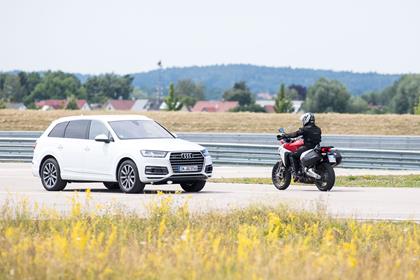Ducati demonstrate new anti-crash tech
Manufacturers are in a race to produce machines that have a much-reduced chance of collisions thanks to a series of new technologies that allow bikes to sense and communicate with other vehicles.
Advances in mobile technology mean that a reality where bikes and cars can communicate their positions with each other and combined Ducati’s intention to introduce danger-sensing radar by 2020 means a crash-free future is more than a dream.
“This is the next step along the path toward accident-free riding – one that doesn’t reduce enjoyment and doesn’t take away motorcyclists’ responsibility,” says Dr Dirk Hoheisel of Bosch, who lead the development of this tech.
![]()
Stage one: radar
Automotive radar technology isn’t that new – cars have been using it for 20 years. It constantly monitors a machine’s position in relation to roadside furniture and other vehicles, so it can then use that information to influence the control of the bike or inform the rider of danger.
Expect the first semi-autonomous aid on bikes to be adaptive cruise control. In this case, the radar system monitors the relative position of the vehicles around it and its ECU has autonomy over the bike’s throttle to maintain a safe gap from the vehicle in front and potentially has the capability to brake if it senses a danger.
Ducati and KTM are also developing a forward collision detection system that will give an audible warning when it first senses danger but in the future also has the potential apply brakes, too.
The use of two radar units at the front and rear will give the potential for blind-spot warning systems as well. Whenever there is a vehicle in the rider’s blind spot, the technology warns them by way of an optical signal, for example in the rear-view mirror.
![]()
Stage two: intervehicle communication
On July 12, Ducati and Audi performed a controlled collision avoidance using two cars and a Multistrada. All the vehicles were equipped with a system that allows them to communicate with each other.
Dubbed Cellular Vehicle-to-Everything technology (C-V2X), it will work on the emerging 5G mobile band and builds up a picture of all the vehicles in an area to provide situational awareness information.
OTHER TECH STORIES
- Synthetic petrol is on its way
- New company launches technology packed helmets
- Electric motorcycles: The buzz so far
Ducati and Audi’s trial last week showcased two types of assistance. The first was Intersection Collision Warning, where a vehicle equipped with C-V2X technology pulls out from a junction and avoids hitting a biker who has the right of way, as well as Across Traffic Turn Collision Risk Warning, in which a vehicle avoids a left-turn collision with a motorcycle.
Cellular Vehicle-to-Everything technology: The key points
- Ducati’s Advanced Radar Assistance System reads the road, monitoring multiple vehicles at the same time
- It senses that a car is slowing, it can warn the rider of a problem or in the future even reduce speed or even brakes automatically
- At the same time a rear radar system can let the rider know that it’s in its blind spot by with a warning light in the rear-view mirror
- In the future each vehicle will be able to communicate with each other, using autonomy to avoid collisions in the first place
- CV2X technology can also allow the vehicle talk to other roadside obstacles like traffic lights, road signs and speed limits
It can be used just to provide warnings for drivers of impeding dangers, which is what occurred in Ducati’s demonstration last week, but as vehicle autonomy grows, there will be the potential for a car’s control system to take over to avoid a collision using the positional data or brake before the driver even knows there is a problem.
Find your next Ducati at MCN Bikes for Sale.


